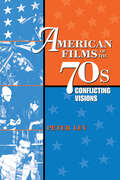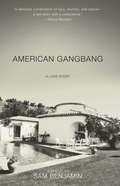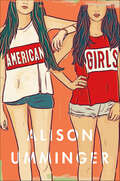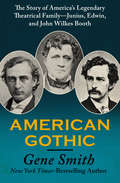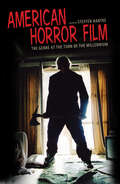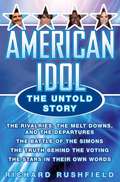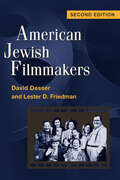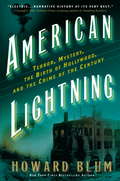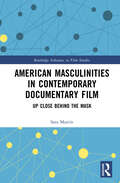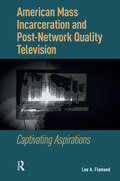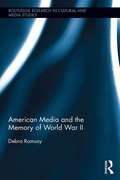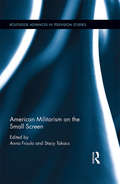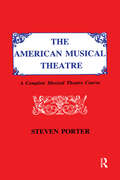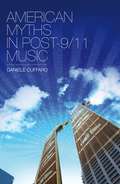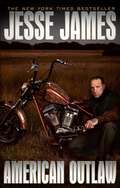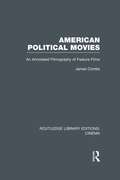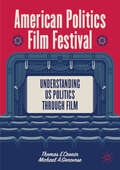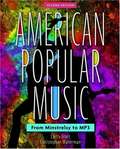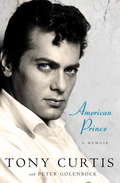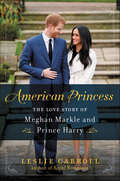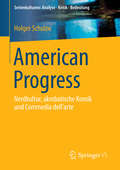- Table View
- List View
American Films of the 70s: Conflicting Visions
by Peter LevWhile the anti-establishment rebels of 1969's Easy Rider were morphing into the nostalgic yuppies of 1983's The Big Chill, Seventies movies brought us everything from killer sharks, blaxploitation, and disco musicals to a loving look at General George S. Patton. Indeed, as Peter Lev persuasively argues in this book, the films of the 1970s constitute a kind of conversation about what American society is and should be—open, diverse, and egalitarian, or stubbornly resistant to change. Examining forty films thematically, Lev explores the conflicting visions presented in films with the following kinds of subject matter: Hippies (Easy Rider, Alice's Restaurant) Cops (The French Connection, Dirty Harry) Disasters and conspiracies (Jaws, Chinatown) End of the Sixties (Nashville, The Big Chill) Art, Sex, and Hollywood (Last Tango in Paris) Teens (American Graffiti, Animal House) War (Patton, Apocalypse Now) African-Americans (Shaft, Superfly) Feminisms (An Unmarried Woman, The China Syndrome) Future visions (Star Wars, Blade Runner) As accessible to ordinary moviegoers as to film scholars, Lev's book is an essential companion to these familiar, well-loved movies.
American Gangbang: A Love Story
by Sam BenjaminA thoughtful, hilarious, and compulsively readable memoir by an Ivy League graduate-turned-pornographer who sets out to bring sophistication and equality to sexual cinema--only to find that he can't change porn, but porn can certainly change him.American Gangbang heralds the arrival of a profound and gifted new voice in narrative nonfiction. In 1999, after four years of studying at Brown University, Sam Benjamin heads to California in a twenty-year-old Volvo, dead set on turning himself into an artist, despite his complete lack of talent. There, stoned, he has an epiphany--he will make progressive porn. And so begins his turbulent journey. . . .In whip-smart, lyrical prose, Benjamin traces his three-year immersion into the world of Hollywood's bleak, screen glow-lit doppelganger: the southern California sex industry. His rapid ascent from the dingy storefront rental of a starving artist to the multimillion-dollar Malibu villa of a full-fledged porn producer confronts him with the uncomfortably alluring realities of America's strangest industry: gun-toting actors, high on terrible, drug-induced potency; giggling actresses battling internal demons in wobbly heels and pink fishnets; the insatiable consumer demands to sink ever lower, more exploitative, nastier. The result is the titillating, dramatic chronicle of a young man who invites the deepest, most troubling parts of himself to rise to the surface in order to get a good look at them--only to find that what he sees makes his world seem suddenly very small.A provocative, universal coming-of-age story, American Gangbang explores with unflinching honesty the darkly rich junction of sex and self-discovery.
American Girls
by Alison UmmingerA bittersweet, honest, and widely acclaimed YA coming-of-age novel that distills honest truths about American girldomAnna is a fifteen-year-old girl slouching toward adulthood, and she's had it with her life at home. So Anna "borrows" her stepmom's credit card and runs away to Los Angeles, where her half-sister takes her in. But LA isn't quite the glamorous escape Anna had imagined.As Anna spends her days on TV and movie sets, she engrosses herself in a project researching the murderous Manson girls—and although the violence in her own life isn't the kind that leaves physical scars, she begins to notice the parallels between herself and the lost girls of LA, and of America, past and present.In Anna's singular voice, we glimpse not only a picture of life on the B-list in LA, but also a clear-eyed reflection on being young, vulnerable, lost, and female in America—in short, on the B-list of life. Alison Umminger writes about girls, violence, and which people society deems worthy of caring about, which ones it doesn't, in a way not often seen in teen fiction.American Girls is:An ALA Booklist Top 10 First Novel A KirkusBest Book of the YearA Barnes & Noble Best YA Book of the YearA Chicago Public Library Best of the Best of 2016A Bustle Best YA Book of the YearYALSA's Best Fiction for Young Adults"Messy, honest, and unflinchingly real. I can't get this book out of my head. I don't want to get this book out of my head." —Becky Albertalli, Morris Award-winning author of Simon vs. the Homo Sapiens Agenda
American Gothic: The Story of America's Legendary Theatrical Family—Junius, Edwin, and John Wilkes Booth
by Gene SmithA New York Times–bestselling author&’s &“lively&” account of a family of famous actors—who became notorious after the assassination of President Lincoln (The New Yorker). Junius Booth and his sons, Edwin and John Wilkes, were nineteenth-century America&’s most famous theatrical family. Yet the Booth name is forever etched in the history books for one terrible reason: the assassination of President Abraham Lincoln by John Wilkes Booth at Ford&’s Theatre on April 14, 1865. In American Gothic, bestselling historian Gene Smith vividly chronicles the triumphs, scandals, and tragedies of this infamous family. The preeminent English tragedian of his day, Junius Booth was a madman and an alcoholic who abandoned his wife and young son to move to America and start a new family. His son Edwin became the most renowned Shakespearean actor in America, famously playing Hamlet for one hundred consecutive nights, but he suffered from depression and a crippling fear of inheriting his father&’s insanity. Blessed with extraordinary good looks and a gregarious nature, John Wilkes Booth seemed destined for spectacular fame and fortune. However, his sympathy for the Confederate cause unleashed a dangerous instability that brought permanent disgrace to his family and forever changed the course of American history. Richly detailed and emotionally insightful, American Gothic is a &“ripping good tale&” that brings to life the true story behind a family tragedy of Shakespearean proportions (The New York Times).
American Horror Film: The Genre at the Turn of the Millennium
by Steffen HantkeCreatively spent and politically irrelevant, the American horror film is a mere ghost of its former self—or so goes the old saw from fans and scholars alike. Taking on this undeserved reputation, the contributors to this collection provide a comprehensive look at a decade of cinematic production, covering a wide variety of material from the last ten years with a clear critical eye. Individual essays profile the work of up-and-coming director Alexandre Aja and reassess William Malone’s much-maligned Feardotcom in the light of the torture debate at the end of President George W. Bush’s administration. Other essays look at the economic, social, and formal aspects of the genre; the globalization of the US film industry; the alleged escalation of cinematic violence; and the massive commercial popularity of the remake. Some essays examine specific subgenres—from the teenage horror flick to the serial killer film and the spiritual horror film—as well as the continuing relevance of classic directors such as George A. Romero, David Cronenberg, John Landis, and Stuart Gordon. Essays deliberate on the marketing of nostalgia and its concomitant aesthetic and on the curiously schizophrenic perspective of fans who happen to be scholars as well. Taken together, the contributors to this collection make a compelling case that American horror cinema is as vital, creative, and thought-provoking as it ever was.
American Idol: The Untold Story
by Richard RushfieldThe currency is fame, and it's bigger than money, more desired than power. Each season American Idol delivers on a promise whose epic scope is unparalleled in the annals of competition: to take an unknown dreamer from the middle of America and turn him or her into a genuine star. It has become not only the biggest show on television, but the biggest force in all of entertainment; its alumni dominate the recording charts and Broadway, win Academy Awards, and sweep up Grammys. In fact, American Idol has reshaped the very idea of celebrity. But it didn't start out that way. When the little singing contest debuted as a summer replacement on the U.S. airwaves, it was packed between reruns and low-cost filler. The promise that it would find America's next pop star produced a hearty round of guffaws from the country's media critics. Now, some ten years and millions of records later, no one is laughing. American Idol: The Untold Story chronicles the triumphs and travails, the harrowing backstage drama and the nail-biting onstage battles that built this revolutionary show. In this revealing book, veteran journalist Richard Rushfield goes deeper inside the circus than any reporter ever has. Candid interviews with Idol alumni, including Simon Fuller and Simon Cowell, shed new light on the show that changed the entertainment industry. And because Rushfield had full access to the people who created the show, starred in it, and kept it atop the pop culture pyramid, this book is the first to take Americans behind the curtain and tell what has really been happening on the world's most watched and speculated-about stage.
American Jewish Filmmakers
by Lester D. Friedman David DesserWoody Allen, Mel Brooks, Sidney Lumet, and Paul Mazursky, all sons of East European Jews, remain among the most prominent contemporary American film directors. In this revised, updated second edition of American Jewish Filmmakers, David Desser and Lester D. Friedman demonstrate how the Jewish experience gives rise to an intimately linked series of issues in the films of these and other significant Jewish directors. The effects of the Holocaust linger, both in gripping dramatic form (Mazursky's Enemies, a Love Story) and in black comedy (Brooks's The Producers). In his trilogy consisting of Serpico, Prince of the City, and Q&A, Lumet focuses on the failure of society's institutions to deliver social justice. Woody Allen portrays urban life and family relationships (Manhattan and Hannah and Her Sisters), sometimes with a nostalgic twist (Radio Days). This edition concludes with a newly written discussion of the careers of other prominent Jewish filmmakers such as Steven Spielberg, Barry Levinson, Brian Singer, and Darren Aronofsky.
American Klezmer: Its Roots and Offshoots
by Mark SlobinKlezmer,the Yiddish word for a folk instrumental musician, today flourishes in the United States and abroad in the world music and accompany Jewish celebrations. The essays collected in this volume investigate American klezmer: its roots, its evolution, and its spirited revitalization. The contributors offer a wide range of perspectives on the musical, social, and cultural history of klezmer in American life.
American Lightning
by Howard BlumIt was an explosion that reverberated across the country--and into the very heart of early-twentieth-century America. On the morning of October 1, 1910, the walls of the Los Angeles Times Building buckled as a thunderous detonation sent men, machinery, and mortar rocketing into the night air. When at last the wreckage had been sifted and the hospital triage units consulted, twenty-one people were declared dead and dozens more injured. But as it turned out, this was just a prelude to the devastation that was to come.In American Lightning, acclaimed author Howard Blum masterfully evokes the incredible circumstances that led to the original "crime of the century"--and an aftermath more dramatic than even the crime itself. With smoke still wafting up from the charred ruins, the city's mayor reacts with undisguised excitement when he learns of the arrival, only that morning, of America's greatest detective, William J. Burns, a former Secret Service man who has been likened to Sherlock Holmes. Surely Burns, already world famous for cracking unsolvable crimes and for his elaborate disguises, can run the perpetrators to ground. Through the work of many months, snowbound stakeouts, and brilliant forensic sleuthing, the great investigator finally identifies the men he believes are responsible for so much destruction. Stunningly, Burns accuses the men--labor activists with an apparent grudge against the Los Angeles Times's fiercely anti-union owner--of not just one heinous deed but of being part of a terror wave involving hundreds of bombings. While preparation is laid for America's highest profile trial ever--and the forces of labor and capital wage hand-to-hand combat in the streets--two other notable figures are swept into the drama: industry-shaping filmmaker D.W. Griffith, who perceives in these events the possibility of great art and who will go on to alchemize his observations into the landmark film The Birth of a Nation; and crusading lawyer Clarence Darrow, committed to lend his eloquence to the defendants, though he will be driven to thoughts of suicide before events have fully played out.Simultaneously offering the absorbing reading experience of a can't-put-it-down thriller and the perception-altering resonance of a story whose reverberations continue even today, American Lightning is a masterpiece of narrative nonfiction.From the Hardcover edition.
American Lightning
by Howard BlumIt was an explosion that reverberated across the country--and into the very heart of early-twentieth-century America. On the morning of October 1, 1910, the walls of the Los Angeles Times Building buckled as a thunderous detonation sent men, machinery, and mortar rocketing into the night air. When at last the wreckage had been sifted and the hospital triage units consulted, twenty-one people were declared dead and dozens more injured. But as it turned out, this was just a prelude to the devastation that was to come.In American Lightning, acclaimed author Howard Blum masterfully evokes the incredible circumstances that led to the original "crime of the century"--and an aftermath more dramatic than even the crime itself. With smoke still wafting up from the charred ruins, the city's mayor reacts with undisguised excitement when he learns of the arrival, only that morning, of America's greatest detective, William J. Burns, a former Secret Service man who has been likened to Sherlock Holmes. Surely Burns, already world famous for cracking unsolvable crimes and for his elaborate disguises, can run the perpetrators to ground. Through the work of many months, snowbound stakeouts, and brilliant forensic sleuthing, the great investigator finally identifies the men he believes are responsible for so much destruction. Stunningly, Burns accuses the men--labor activists with an apparent grudge against the Los Angeles Times's fiercely anti-union owner--of not just one heinous deed but of being part of a terror wave involving hundreds of bombings. While preparation is laid for America's highest profile trial ever--and the forces of labor and capital wage hand-to-hand combat in the streets--two other notable figures are swept into the drama: industry-shaping filmmaker D.W. Griffith, who perceives in these events the possibility of great art and who will go on to alchemize his observations into the landmark film The Birth of a Nation; and crusading lawyer Clarence Darrow, committed to lend his eloquence to the defendants, though he will be driven to thoughts of suicide before events have fully played out.Simultaneously offering the absorbing reading experience of a can't-put-it-down thriller and the perception-altering resonance of a story whose reverberations continue even today, American Lightning is a masterpiece of narrative nonfiction.From the Hardcover edition.
American Lightning: Terror, Mystery, and the Birth of Hollywood
by Howard BlumIt was an explosion that reverberated across the country--and into the very heart of early-twentieth-century America. On the morning of October 1, 1910, the walls of the Los Angeles Times Building buckled as a thunderous detonation sent men, machinery, and mortar rocketing into the night air. When at last the wreckage had been sifted and the hospital triage units consulted, twenty-one people were declared dead and dozens more injured. But as it turned out, this was just a prelude to the devastation that was to come. In American Lightning, acclaimed author Howard Blum masterfully evokes the incredible circumstances that led to the original "crime of the century"--and an aftermath more dramatic than even the crime itself. With smoke still wafting up from the charred ruins, the city's mayor reacts with undisguised excitement when he learns of the arrival, only that morning, of America's greatest detective, William J. Burns, a former Secret Service man who has been likened to Sherlock Holmes. Surely Burns, already world famous for cracking unsolvable crimes and for his elaborate disguises, can run the perpetrators to ground. Through the work of many months, snowbound stakeouts, and brilliant forensic sleuthing, the great investigator finally identifies the men he believes are responsible for so much destruction. Stunningly, Burns accuses the men--labor activists with an apparent grudge against the Los Angeles Times' fiercely anti-union owner--of not just one heinous deed but of being part of a terror wave involving hundreds of bombings. While preparation is laid for America's highest profile trial ever--and the forces of labor and capital wage hand-to-hand combat in the streets--two other notable figures are swept into the drama: industry-shaping Filmmaker D. W. Griffith, who perceives in these events the possibility of great art and who will go on to alchemize his observations into the landmark film The Birth of a Nation; and crusading lawyer Clarence Darrow, committed to lend his eloquence to the defendants, though he will be driven to thoughts of suicide before events have fully played out. Simultaneously offering the absorbing reading experience of a can't-put-it-down thriller and the perception-altering resonance of a story whose reverberations continue even today, American Lightning is a masterpiece of narrative nonfiction.
American Masculinities in Contemporary Documentary Film: Up Close Behind the Mask (Routledge Advances in Film Studies)
by Sara MartínMost documentaries deal with men, but what do they actually say about masculinity? In this groundbreaking volume Sara Martín analyses more than forty 21st-century documentaries to explore how they represent American men and masculinity. From Jennifer Siebel Newsom’s The Mask You Live In to Raoul Peck’s I Am Not Your Negro, this volume explores sixteen different faces of American masculinity: the good man, the activist, the politician, the whistleblower, the criminal, the sexual abuser, the wrongly accused, the dependent man, the soldier, the capitalist, the adventurer, the sportsman, the architect, the photographer, the musician, and the writer. The collective portrait drawn by the documentaries discloses a firm critical stance against the contradictions inherent in patriarchy, which makes American men promises of empowerment it cannot fulfill. The filmmakers’ view of American masculinity emphasizes the vulnerability of disempowered men before the abuses of the patriarchal system run by hegemonic men and a loss of bearings about how to be a man after the impact of feminism, accompanied nonetheless by a celebration of resilient masculinity and of the good American man. Firmly positioning documentaries as an immensely flexible, relevant tool to understand 21st-century American men and masculinity, their past, present, and future, this book will interest students and scholars of film studies, documentary film, American cultural studies, gender, and masculinity.
American Mass Incarceration and Post-Network Quality Television: Captivating Aspirations
by Lee FlamandFar more than a building of brick and mortar, the prison relies upon gruesome stories circulated as commercial media to legitimize its institutional reproduction. Perhaps no medium has done more in recent years to both produce and intervene in such stories than television. This unapologetically interdisciplinary work presents a series of investigations into some of the most influential and innovative treatments of American mass incarceration to hit our screens in recent decades. Looking beyond celebratory accolades, Lee A. Flamand argues that we cannot understand the eagerness of influential programs such as OZ, The Wire, Orange Is the New Black, 13th, and Queen Sugar to integrate the sensibilities of prison ethnography, urban sociology, identity politics activism, and even Black feminist theory into their narrative structures without understanding how such critical postures relate to the cultural aspirations and commercial goals of a quickly evolving TV industry and the most deeply ingrained continuities of American storytelling practices.
American Media and the Memory of World War II (Routledge Research in Cultural and Media Studies)
by Debra RamsayFor three generations of Americans, World War II has been a touchstone for the understanding of conflict and of America’s role in global affairs. But if World War II helped shape the perception of war for Americans, American media in turn shape the understanding and memory of World War II. Concentrating on key popular films, television series, and digital games from the last two decades, this book explores the critical influence World War II continues to exert on a generation of Americans born over thirty years after the conflict ended. It explains how the war was configured in the media of the wartime generation and how it came to be repurposed by their progeny, the Baby Boomers. In doing so, it identifies the framework underpinning the mediation of World War II memory in the current generation’s media and develops a model that provides insight into the strategies of representation that shape the American perspective of war in general.
American Militarism on the Small Screen (Routledge Advances in Television Studies)
by Anna Froula Stacy TakacsAnna Froula is Associate Professor of Film Studies in the Department of English at East Carolina University, USA Stacy Takacs is Associate Professor and Director of American Studies at Oklahoma State University, USA
American Musical Theatre
by Steven PorterFirst Published in 1987. Split into four parts, this book seeks to inform the reader, teachers, directors and students about American Musical Theatre. Part I is a brief history of the American Musical Theatre, for it is only in the context of history that the material on which you work can be fully judged and mastered. Part II is a brief discussion of the elements of production. Knowing what ought to take place in a well-planned show can go a long way toward counteracting what does not take place in a poorly planned one. Part III is a brief discussion of how to evaluate the elements of craftmanship one expects to find in the writing and performing of a musical. The knowledge here is indispensable to the performer. It is the feel of the plane to the pilot, the touch of the key to the pianist. It is, in fact, the very life blood of the art form. Finally, Part IV provides an opportunity to put into practice what previous study has taught.
American Myths in Post-9/11 Music
by Daniele CuffaroAfter September 11, 2001, the void left following the attack on the Twin Towers in the heart of New York was the visible symbol that there was to be a breaking point with the past. The attacks dramatically changed the everyday lives of the American people and the new devastating landscape led people to seek to restore the certainties that had been so suddenly shattered. In doing this, Americans went back to the historical myths in their culture. This book explores the collective memory and historical American myths like, for example, the myth of the innocent nation and the frontier myth, and shows how some of these nationally considered historical truths have not disappeared, but were indeed exhumed in the music produced post-9/11.
American Outlaw
by Jesse JamesThe New York Times bestselling self-portrait of a flawed but determined everyman: rebel, outlaw, gearhead, artist, entrepreneur, lost son, and fiercely committed father Jesse James is everything you imagined him to be-- and more than you ever expected. He has led a violent life. He's survived lower depths, faced harder times, and beaten down more private demons than most--and lived to tell his story with honesty, introspection, and humility. He's tough as nails and riding hard through life, with plenty of wisdom to share about taking a hit and coming back up. In American Outlaw, Jesse reveals all: from his volatile upbringing and troubled relationship with his father to his wild days of car thieving and juvenile detention; from knocking heads as a rock 'n' roll bodyguard to his destructive drinking and barroom brawling; from building an empire from the ground up to marriages marked with both happiness and gut-wrenching pain; from living inside the hottest level of paparazzi hell to rehab and making peace with his past.
American Political Movies: An Annotated Filmography of Feature Films (Routledge Library Editions: Cinema)
by James CombsEssays here explore the relationship between politics and explicitly political feature films from the beginning of the movie industry to World War I, and for each decade through to the 1980's. The included filmography is particularly useful. Originally published in 1990, the method of inquiry put forward in this text is nonetheless extendable to the decades following its publication.
American Politics Film Festival: Understanding US Politics through Film
by Thomas E.Cronin Michael A.GenoveseThis is an innovative and inspirational examination of films and documentaries that helps us explain the evolution of, struggles of, and aspirations of the American experiment. This book sorts politics into categories and then identifies films, TV shows, and documentaries that illuminate various aspects of that category. For each chapter, the authors list and discuss an impressive variety of films, documentaries, and television shows. This accessible book is designed for course use and general readers interested in how American politics and history has been portrayed in media.
American Popular Music: From Minstrelsy To Mp3
by Larry Starr Christopher WatermanIn American Popular Music: From Minstrelsy to MP3, Second Edition, Larry Starr and Christopher Waterman examine popular music in the United States from its beginnings into the 21st century, offering a comprehensive look at the music, the cultural history of the times, and the connections between them. Using well-chosen examples, insightful commentaries, and an engaging writing style, this text traces the development of jazz, blues, country, rock, Motown, hip-hop, and other popular styles,highlighting the contributions of diverse groups to the creation of distinctly American styles. It combines an in-depth treatment of the music itself--including discussions of stylistic elements and analyses of musical examples--with solid coverage of the music's attendant historical, social, and cultural circumstances. The authors incorporate strong pedagogy including numerous boxed inserts on significant individuals, recordings, and intriguing topics; coverage of early American popular music; and a rich illustration program. Detailed listening charts explain the most important elements of recordings discussed at length in the text. The charts are complemented by two in-text audio CDs and--new to this edition--an iMix published at iTunes, which makes most of the songs immediately available to students and instructors. Features of the Second Edition * Integrates full color throughout * Provides more coverage of women artists, with new material on women in rock 'n' roll inChapter 8 and a box on Queen Latifah in Chapter 14 * Reorganizes the discussion of post-1970s music: disco is now included with mainstream 70s pop, while hip-hop is treated in two chapters (12 and 14) in order to emphasize its significance and diversity * Adds new material on the recent alternative country music explosion * Includes new developments in music technology in the thoroughly revised concluding chapter * Offers revised and more vivid visual elements, including more than 100 new photos (most in full color) and an illustrated timeline * Provides redesigned listening guides, enhanced by an iMix published at iTunes (accessible at www. oup. com/us/popmusic) * Supplemented by a Companion Website at www. oup. com/us/popmusic (containing both student and instructor resources) and an Instructor's Manual and a Computerized Test Bank on CD * FREE with the purchase of this book: a 6-month subscription to Grove Music Online (www. grovemusic. com)--a $180 value Remarkably accessible,American Popular Music, Second Edition, is ideal for courses in American Popular Music, the History of Popular Music, Popular Music in American Culture, and the History of Rock 'n' Roll. Its welcoming style and warm tone will captivate readers, encouraging them to become more critically aware listeners of popular music.
American Prince: A Memoir
by Tony Curtis"All my life I had one dream and that was to be in the movies. " He was the Golden Boy of the Golden Age. A prince of the silver screen. Dashing and debonair, Tony Curtis arrived on the scene in a blaze of bright lights and celluloid. His good looks, smooth charm, and natural talent earned him fame, women, and adulation--Elvis copied his look and the Beatles put him on their Sgt. Pepper album cover. But the Hollywood life of his dreams brought both invincible highs and debilitating lows. Now, in his captivating, no-holds-barred autobiography, Tony Curtis shares the agony and ecstasy of a private life in the public eye. No simple tell-all,American Princechronicles Hollywood during its heyday. Curtis revisits his immense body of work--including the unforgettable classics Houdini, Spartacus, and Some Like It Hot--and regales readers with stories of his associations with Frank Sinatra, Laurence Olivier, director Billy Wilder, and film industry heavyweight Lew Wasserman, as well as paramours Natalie Wood and Marilyn Monroe, among others. As forthright as he is enthralling, Tony Curtis offers intimate glimpses into his succession of failed marriages (and the one that has endured), his destructive drug addiction, and his passion as a painter. Written with humor and grace,American Princeis a testament to the power of living the life of one's dreams.
American Princess: The Love Story of Meghan Markle and Prince Harry
by Leslie CarrollA behind-the-scenes look into the life of Meghan Markle and her romance with Prince Harry—a dishy, delightful must-read filled with exclusive insights for anyone obsessed with the Royal Family.Leslie Carroll’s books on royalty are “an irresistible combination of People Magazine and the History Channel.”—Chicago TribuneWhen Prince Harry of Wales took his American girlfriend, Meghan Markle, to have tea with his grandmother the queen, avid royal watchers had a hunch that a royal wedding was not far off. That prediction came true on November 27, 2017, when the gorgeous, glamorous twosome announced their engagement to the world. As they prepare to tie the knot in a stunning ceremony on May 19, 2018, that will be unprecedented in royal history, people are clamoring to know more about the beautiful American who captured Prince Harry’s heart. Born and raised in Los Angeles to a white father of German, English, and Irish descent and an African American mother whose ancestors had been enslaved on a Georgia plantation, Meghan has proudly embraced her biracial heritage. In addition to being a star of the popular television series Suits, she is devoted to her humanitarian work—a passion she shares with Harry. Though Meghan was married once before, Prince Harry is a modern royal, and the Windsors have welcomed her into the tight-knit clan they call “The Firm.” Even a generation ago, it would have been unthinkable, as well as impermissible, for any member of Great Britain’s royal family to consider marrying someone like Meghan. Professional actresses were considered scandalous and barely respectable. And the last time an American divorcee married into the Royal Family, it provoked a constitutional crisis!In American Princess, Leslie Carroll provides context to Harry and Meghan’s romance by leading readers through centuries of Britain’s rule-breaking royal marriages, as well as the love matches that were never permitted to make it to the altar; followed by a never-before-seen glimpse into the little-known life of the woman bringing the Royal Family into the 21st century; and her dazzling, thoroughly modern romance with Prince Harry.
American Profile Hometown Cookbook: A Celebration of America's Table
by Mary Carter Susan Fisher Candace Floyd"In this extraordinary cookbook, you'll find traditional American favorites with a unique twist alongside ethnic creations from around the world. Also included are helpful tips from American Profile's test kitchen as well as 30 articles on hometown festivals and fairs across the nation that give you a sneak peek into the lives of the ordinary citizens that make up hometown America. Whether it's a simple soup for the family or a full meal for visitors, the American Profile Hometown Cookbook has just the right recipe to make any gathering a special occasion."
American Progress: Nerdkultur, akrobatische Komik und Commedia dell'arte (Serienkulturen: Analyse – Kritik – Bedeutung)
by Holger SchulzeDie Serie 30Rock wälzt die medialen Erzählungen ihrer Epoche (und der Serie selbst) unaufhörlich um: in bislang sieben Staffeln, 140 Episoden, von 30 Autoren für 14 SchauspielerInnen geschrieben - rund um die Erfinderin und Hauptdarstellerin Tina Fey. Dieser Band untersucht die überdrehte Gegenwartsdystopie, ihre Erzählungen, Bühnen und Personen. Markante Episoden werden im Zusammenhang zeitgenössischer Pop- und TV-Kultur untersucht und einzelne ProtagonistInnen in ihrem medialen Handeln und dessen Referenzen. Ein Tableau der Medien- und der Nerdkultur sowie der politischen Agitation entsteht in Form von akrobatischer Komik und Celebrityobsession: eine Form der Commedia dell'arte über den American Progress.
